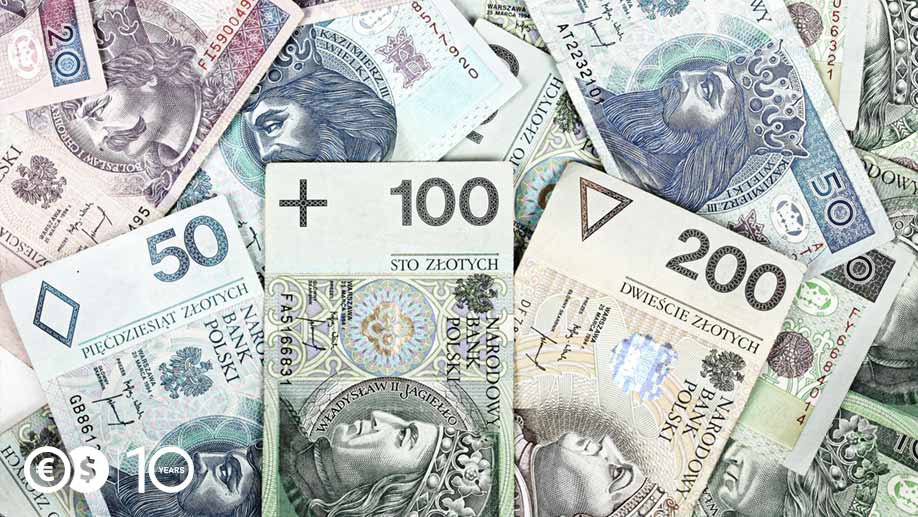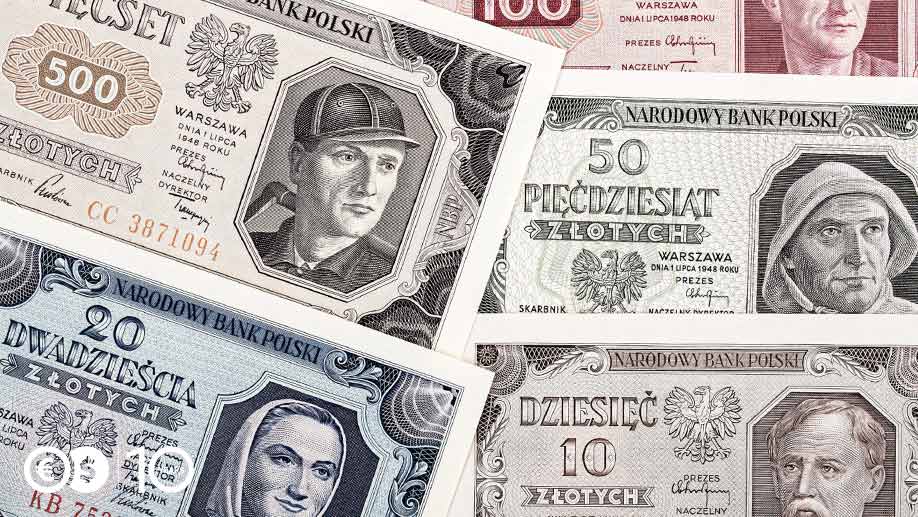The first Polis zloty coins appeared in circulation in the second half of the 17th century. However, the history of the Polish currency reaches further back and has its roots in pennies, ducats and florins. The history of the currency was fickle, but in the end, it managed to survive even when invaders plundered the Polish lands.

The zloty as a monetary unit
Before the first coins known as "zloty" were used, they functioned as a unit of account used to determine the value of a property. Its value was established in the Statutes of Piotrkow in 1496 as 30 groszy.
This was the time of geographical discoveries. From the New World, silver was brought, which was used to produce silver coins. Large quantities of silver made it lose its value against gold and gold coins. Therefore, the exchange rate to a gold florin was fixed at 30 groszy. Over time, the value of the gold coin increased even more, to reach as much as 360 groszy in 1676.
Although gold coins were appreciating, the fixed value of the unit of account, which was the zloty, remained the same until the 19th century. It invariably was 30 groszy.
A good joke is worth a tymf
The first coins, which came to be known as zloty, appeared in Poland after the Swedish Deluge. The country was getting back on its feet after the devastating war and needed some sort of "loan". That is why silver coins worth 30 groszy started to be minted in 1663. In reality, the silver bullion content was much lower, and the real value was about 17-18 groszy.
The country's poor economic condition justified this apparent forgery. The originator of this initiative was Andrzej Tymf, a German minter who managed the royal mints. The coins were commonly called tymfs after his name. This was also the origin of the ironic Polish saying, "A good joke is worth a tymf" (Dobry żart tynfa wart), which cast doubt on the quality of the money.
Tymfs were not only characterized by their low value. They were minted carelessly and on a colossal scale, which quickly led to high inflation and an economic crisis that the country struggled to cope with for the next several decades. Meanwhile, Andrew Tymf was accused of numerous accounts of abuse by the nobility. Ultimately, nothing was ever proven, but in 1667 he fled Poland.
At that time, people in Poland used many different coins. Apart from the dubious quality of tymfs, there were also pennies, boratynka, thalers, and coins minted abroad. Stanislaw August Poniatowski, the last king of the Polish-Lithuanian Commonwealth, made an attempt to reform the monetary market. He ordered the introduction of the zloty as the basic unit and to withdraw other coins from circulation.
Silver thalers began to be minted, which were supposed to suppress inflation caused by ill-favoured tymfs. However, it was quickly realized that the money was of better quality than the coins produced abroad, so the Prussians began to export them out of the country, flooding the Polish market with coins of poorer quality. For this reason, it was decided that the share of silver in Polish coins should be lower. Mass-minted copper coins, whose value was conventional and did not reflect the real state, were also introduced into circulation.
Therefore, during the reign of Stanislaw August, two monetary systems were used - silver and copper. The zloty still reflected the value of 30 groszy, but in copper. In the case of silver, it was worth only 4 groszy. Saxon coins of 1/6th and 1/3rd of a thaler circulated, which people called zlotys and two-zlotys.
The downfall of the country, but not of the money
The first Polish banknotes appeared in 1794, during the Kosciuszko Uprising after the Second Partition of Poland. The country plunged into war lacked money as well as bullion to mint coins. So it was decided to issue treasury tickets of a certain value, which would be exchanged for bullion after the uprising. Unfortunately, this promise was never fulfilled because the uprising collapsed, and the invaders wanted to eliminate all traces of Polish currency.

Polish coins were supposed to disappear from circulation, although due to their good quality, the population was reluctant to get rid of them. Even when the invaders' money appeared on the market, it was still given Polish names.
The zloty came back into circulation after the creation of the Duchy of Warsaw and, following its collapse after the formation of the Kingdom of Poland, which was allowed to have its own currency. Coins minted then contained Polish, not Latin, inscriptions. The money was also tied to the Russian currency system. The Polish zloty worth 30 groszy was exchangeable for 15 Russian kopecks.
The need to convert currencies brought 5- and 10-zloty coins into circulation, replacing thalers and half-thalers, as well as 25- and 50-zloty coins, which replaced ducats. The latter two were called single and double royal zlotys.
In 1828, the Bank of Poland began to operate in the Kingdom of Poland, laying the foundations for Polish banking. It was responsible for the issue of the Polish zloty, gave loans and financed some undertakings - e.g. road construction.
After the unsuccessful November Uprising, the Russianization of the Polish Kingdom began. On the coins, apart from Polish inscriptions, Russian ones appeared, and the Polish eagle was replaced by St. George, the patron saint of Moscow. The value of the coin was marked in two currencies - zlotys and kopecks. The zloty dropped out of circulation completely in 1841. By a Russian tsar's decree, it was replaced by the ruble, which was divided into 100 kopecks. The Bank of Poland was dissolved and the State Bank of Russia took over its assets.
The Polish mark, lechs and the new dawn of the Polish zloty
In the Second Republic of Poland, the Polish mark was the legal tender created before the end of World War I, in 1916, in the territories occupied by the Germans. It functioned only in the form of banknotes. Although there were plans to mint coins - even a few test designs were created, but eventually, they never entered into circulation.
The mediocre economic situation of the Second Republic caused inflation to rise rapidly in the country. Polish marks were printed without a cover, so eventually, the phenomenon of hyperinflation occurred, which forced the authorities to carry out a currency reform.
As early as 1919, it was decided to introduce new money. However, there were disputes over the name - among the proposals were "lech", "piast", "pol", and even "kosciuszko". Jozef Pilsudski finally signed a decree indicating that the new currency would be lech, divided into 100 groszy.
This name was opposed by, among others, Stanislaw Karpinski, head of the Polish National Loan Fund (Polska Krajowa Kasa Pożyczkowa), which was responsible for issuing the money. He argued that before the Great War and the partitions, the name zloty functioned. The Legislative Parliament agreed with his opinion, and in 1919 repealed the decree of Marshal Pilsudski. Eventually, the new currency of the Second Republic was the Polish zloty, which did not appear in circulation until 1924.
During interwar Poland, the zloty, while also not resisting inflation, was a rather stable currency. It was equivalent to 9/31 of a gram of pure gold. Its position can be illustrated through the fact that it was equal to the Swiss franc.
The situation changed after the outbreak of World War II. The initial phase of the Nazi occupation of Poland brought reichsmarks, which were the official means of payment. Quickly, however, the Emission Bank in Poland was established, at the head of which the Nazis placed Feliks Mlynarski, who had previously held the position of vice-president of the Bank of Poland.
As a result, the name of the zloty was kept as the Polish currency. The crowned eagle was missing from the new banknotes. However, Mlynarski negotiated to keep the inscriptions in Polish. Already in 1940, the interwar banknotes were exchanged for those issued under the occupation. Limits of exchange were also established - one for Poles, another for Germans living in the General Government and different again for Jews.
The post-war fate of the Polish zloty
Until 1950 in postwar Poland, only banknotes with denominations from 1 to 500 zloty were used. No coins were used. An unexpected reform came only on October 30, 1950. It was then that new banknotes and coins were introduced.
This reform was kept secret almost to the last minute. An unfavourable exchange rate between old and new banknotes was set. Salaries and prices were converted at a ratio of 3 new zlotys to 100 old ones, while savings at a ratio of 1:100. This way, the Soviets robbed Poles of two-thirds of their savings. There was also a very short deadline for exchanging old money for new. It had to be done by November 8, which was just over a week.
A blow was also struck to those who kept gold. Trading in gold and foreign currencies was banned. The mere possession of gold was punishable by 15 years of imprisonment and even the death penalty for trading. Of course, the population could exchange gold for money, but at an outrageous rate, so most people chose to bury the bullion in the ground.
At that time, no images of Polish national heroes were used on coins and banknotes. Instead, working people were depicted - a farmer, a florist, a labourer, a fisherman and a miner. Changes in the approach to designs came only in the 1970s. The "Great Poles" series brought Karol Swierczewski, Ludwik Warynski, Jaroslaw Dabrowski, Tadeusz Kosciuszko, Mikolaj Kopernik, as well as Mieszko I and Boleslaw Chrobry into Poles' wallets.
The end of the People's Republic of Poland was a time of hyperinflation. Therefore, banknotes of increasingly larger denominations were in circulation - 10,000 PLN, 20,000 PLN, 50,000 PLN and even 200,000 PLN. The last one was exceptional because it did not contain an image of a "Great Pole". Responding to the constantly rising prices, more banknotes were issued, with denominations of 500,000 PLN, 1,000,000 PLN or 2,000,000 PLN. A banknote with Pilsudski's image was also planned, but in the end, the denomination was changed.
Four zeros were taken away
On January 1, 1995, the currency was denominated, and new banknotes were put into circulation in Poland. They functioned alongside the old ones until the end of 1996, which is why stores displayed two prices. One new zloty equaled 10,000 old ones. To quickly convert the value, four zeros had to be erased from the old price.
In the new series of banknotes images of great Poles were replaced by images of the Polish rulers: Mieszko I, Boleslaw Chrobry, Kazimierz Wielki, Wladyslaw Jagiello and Zygmunt I Stary. These are figures well known to Poles, as these banknotes are still in use today. On February 10, 2017, 500-zloty banknotes depicting Jan III Sobieski also came into circulation. The currently existing banknotes of the Polish zloty are some of the most modern and best-secured in the world.




